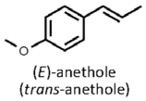 Pimpinella anisum
Pimpinella anisum
anise • aniseed
Back to “Spices: anise (Pimpinella anisum)fr”
Pimpinella anisum L. (Apiaceae); anys (Afrikaans); yan kok, pa chio (Chinese); anis vert (French); saunf (Hindi); Anis (German); anice verde (Italian); anis, erva-doce (Portuguese); anis (Spanish)
DESCRIPTION The small dry fruits or schizocarps, referred to as “aniseed”, are greyish brown in colour, 3−6 mm (⅛−¼ in.) long and have the characteristic sweet and aromatic smell and taste of anise (resembling star anise, fennel and liquorice).
THE PLANT An erect annual herb growing to a height of about 0.6 m (2 ft). It has markedly dimorphic leaves, with the basal ones long-stalked, broad and rounded and the upper ones subsessile and pinnate with narrow segments. The small white flowers are borne in typical umbels.
ORIGIN Eastern Mediterranean (Greece and Egypt) and cultivated since 2000 BC.1 Anise has a long history as medicinal herb in ancient Greece (e.g. to sweeten the breath) and as a culinary spice used by the Romans, Arabs and British since the Middle Ages.2
CULTIVATION Anise is still an important crop, grown commercially in Turkey, Spain, China, Italy, India and other countries.2 Anise oil has largely been replaced by the less expensive star anise oil from China. Anise requires full sun, good fertile soil and warm growing conditions. Seedlings do not transplant well so it is best to establish the plants by direct sowing.
HARVESTING The above-ground parts are harvested at the end of summer when the fruits start to ripen and are then dried and processed.
CULINARY USES Anise has a strong flavour and is used sparingly as a spice in soufflés, meat dishes (soups, stews, sausages), shellfish, vegetables (cabbage, carrots, turnips), mild cheeses, salad dressings, pickles, fruit dishes, desserts and juices. Chopped fresh leaves can be used in salads, pickled vegetables and fish soups. Star anise is nowadays often used as a substitute but connoisseurs say anise has a more delicate aroma. Anise is well known for its applications in confectionery (breads, biscuits, cakes and sweets) as well as alcoholic and non-alcoholic beverages. Examples of traditional culinary items and sweets are Australian humbugs, Austrian anisbögen, British aniseed balls, Dutch muisjes, German Pfeffernüsse and Springerle, Indian candy-coated saunf (used as mukhwas to freshen the breath after a meal), Italian pizzelle, New Mexican bizcochitos, New Zealand aniseed wheels, Norwegian knotts and Peruvian picarones. Well-known anise liqueurs or brandies/liquors (i.e. respectively with or without sugar) include French anisette, pastis and Pernod, Greek ouzo, Middle Eastern arrack, Italian sambuca, Spanish anís and Turkish raki. These are drunk with a glass of water on the side or more often directly diluted with water, resulting in the familiar ouzo effect (the drink becomes cloudy and milky because the alcohol-soluble anethole is no longer fully soluble and forms an emulsion).
FLAVOUR COMPOUNDS The fruits contain 1−4% essential oil with (E)-anethole, also referred to as trans-anethole, as the dominant compound (up to 90% or more) and several minor ingredients such as cis-γ-himachalene, trans-pseudoisoeugenyl 2-methylbutyrate, methylchavicol and p-anis-aldehyde.3 Anethole is a phytoestrogen that also occurs in fennel.

NOTES In Pakistani and Indian cuisine, no distinction is made between anise and fennel – both are called saunf. In Southeast Asia, the name for star anise is sometimes shortened to anis.
1. Mabberley, D.J. 2008. Mabberley’s plant-book (3rd ed.). Cambridge University Press, Cambridge.
2. Farrel, K.T. 1999. Spices, condiments and seasonings. Aspen Publishers, Gaithersburg, USA.
3. Rodrigues, V.M., Rosa, P.T.V., Marques, M.O.M., Petenate, A.J., Meireles, M.A.M. 2003. Supercritical extraction of essential oil from aniseed (Pimpinella anisum L.) using CO2: Solubility, kinetics, and composition data. Journal of Agricultural and Food Chemistry 51: 1518−1523.